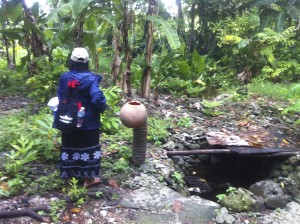Chuuk consists of a central semi-atoll with dozens of mountainous islands enclosed by a barrier reef, and hundreds of smaller low lying islets scattered across the surrounding ocean. Most of Chuuk’s 50,000 people live on high islands that are densely populated yet lack public water infrastructure. Only Weno, the largest island and Chuuk’s capital, has a modern public water system and treatment plant. Rainwater, surface water, and groundwater are all employed as sources of drinking water throughout Chuuk.
The Water for Life Core Team in Chuuk has focused on improving several groundwater springs to enhance access to high quality drinking water. A spring on the island of Tol that provides the best available local water has been improved through creating a cement catchment basin and cover, to minimize contamination. The newly built, enlarged reservoir is also being piped ~200m off privately owned land to a tap on a public shoreline.
A similar project has been completed in Mwan village, another community that relies on a groundwater spring. Seven more such projects are now scheduled to be completed within the upcoming months.
A local artist created a large, colorful billboard, originally displayed across from the College of Micronesia campus in Weno. This billboard, in Chuukese, promotes the protection of local streams. The billboard has been re-located to the powerplant gate that sits on the small hill at the intersection going up to the government offices.

